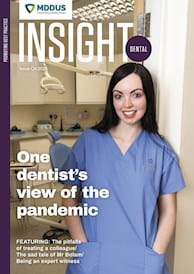These case summaries are based on MDDUS files and are published here to highlight commons pitfalls and encourage proactive risk management. Details have been changed to maintain confidentiality.
BACKGROUND
Mr J attends his dental practice with pain in his lower right jaw. The GDP notes a partially erupted LR8 exuding pus on probing. A radiograph reveals extensive decay and the patient is referred for extraction.
An appointment is arranged with an oral surgeon – Dr N – and the patient notes record: Risks discussed including bruising, swelling, numb lip and tongue. The extraction is undertaken in the same visit and Dr N later describes it as "difficult". He did not raise a lingual flap but had to remove some distal bone to allow tooth removal. Mr J is given verbal and written post-operative instructions.
Mr J returns to Dr N over a week later complaining of numbness in his lip and tongue. The patient is advised that the paraesthesia is partial and should resolve in a few weeks, but to return if there is no improvement in symptoms.
Two months later Mr J attends his GDP and reports that he is still experiencing numbness along the side of his tongue. The GDP writes to Dr N and an appointment is arranged. Here Dr N notes: residual paraesthesia at distal margin tongue.
A referral is made to a specialist in trigeminal nerve conditions and examination concludes a diagnosis of iatrogenic lingual nerve injury leading to permanent paraesthesia. At this appointment the initial lip numbness was noted to have resolved.
A solicitor’s letter is later sent to Dr N claiming clinical negligence. It is alleged that he failed to appropriately advise Mr J of associated risks and treatment options and thus obtain informed consent prior to extraction. The letter further claims that Dr N failed to use appropriate care and skill in the extraction of LR8, resulting in permanent nerve damage.
ANALYSIS/OUTCOME
MDDUS acting for Dr N commissions an expert oral surgeon to report on the case.
The expert reviews the clinical notes and concludes that, considering the extent of decay observed in the radiograph, extraction was the only viable treatment option. Coronectomy could have been discussed but would have been contraindicated due to the extent of the decay present, with retained roots becoming a potential source of infection at a later date.
The expert observes that the clinical records state the patient was warned of some post-operative complications, including numbness of the lip and tongue, but there is no specific description of the diagnosis, type of impaction, root morphology or relation to the inferior alveolar nerve. Consent appears to have been verbal rather than written. He concludes that the consenting process apparent from the records and as reported by Mr J fails to demonstrate compliance with current legal standards – in particular discussing risks of specific relevance to the patient.
In regard to surgical technique, the expert observes that LR8 was a disto-angular impaction and contemporary surgical practice is that if the tooth cannot be simply elevated, then a buccal flap should be raised with buccal bone removal and division of the tooth from that side to allow safe elevation.
Dr N in his comments on the case describes buccal and distal guttering, which refers to bone removal on the buccal and distal aspect of the tooth. The expert assumes that it was the distal bone removal that caused lingual nerve damage. He comments that a small amount of distal bone can be removed under direct vision if soft tissue access allows, but blind removal of bone that can perforate the lingual plate of bone and cause nerve injury is directly contra-indicated.
In summary the expert concludes that there was a breach of duty in relation to both the nature of the consent process and the quality of clinical record keeping – but most crucially in the removal of distal bone, which caused direct nerve injury.
MDDUS in agreement with Dr N offers to settle the case.
KEY POINTS
- Ensure discussion of all ‘material’ risks to the patient is part of the consenting process and is recorded in the notes.
- Record reasoning and justification behind clinical decisions.
- Ensure treatment is informed by up-to-date clinical guidelines.
This page was correct at the time of publication. Any guidance is intended as general guidance for members only. If you are a member and need specific advice relating to your own circumstances, please contact one of our advisers.
Read more from this issue of Insight Dental

Save this article
Save this article to a list of favourite articles which members can access in their account.
Save to library